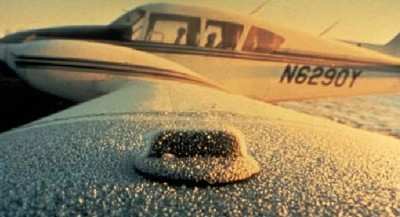Aero-Tips!
A good pilot is always learning -- how many times have you heard
this old standard throughout your flying career? There is no truer
statement in all of flying (well, with the possible exception of
"there are no old, bold pilots.")

Aero-News has called upon the expertise of Thomas P. Turner,
master CFI and all-around-good-guy, to bring our readers -- and us
-- daily tips to improve our skills as aviators. Some of them, you
may have heard before... but for each of us, there will also be
something we might never have considered before, or something that
didn't "stick" the way it should have the first time we memorized
it for the practical test.
Look for our daily Aero-Tips segments, coming each day to you
through the Aero-News Network.
Aero-Tips 09.06.06
It's not too early in the season to review the formation of
frost.
Frost forms on cold nights when the skies are clear, generally
when winds are light. When surface temperatures reach the freezing
point and enough moisture is present to condense in the cold air,
frost will almost certainly crystallize.
Note: Cloudy skies and/or winds greater
than a few miles per hour will usually prevent frost formation.
Exception: in fog, which may form in as much as moderate winds,
heavy frost may collect as saturated air blows onto cold aircraft
surfaces.
Frost forms most quickly on metal and smooth or glassy
surfaces-exactly the materials most wings are made of. You'll see
frost on wings, tails and windscreens long before it forms on the
surrounding ground-smooth metal or fiberglass surfaces will cool
faster than the ground, so they may be below freezing when other
surfaces' temperatures are still above the freezing point. Frost
forms in crystals (very important for aviators-more in a moment),
so once the first crystals form the frost will spread quickly
across the rest of the chilled surface.
Why it's important
Frost may be pretty to look at, but it can have a significantly
detrimental effect on flying. The crystalline structure of frost
creates turbulence in the airflow nearest the wing -- the boundary
layer -- and will degrade lift development, accelerating the stall.
Worse yet, the loss of lift is unpredictable, and may not be
symmetric from one wing to the other.

Because there is no way to predict the aerodynamics of a
frost-contaminated airfoil the only safe approach to flight is to
remove the frost completely from all flying surfaces before
attempting to take off. The best method is to move the airplane
into a heated hangar, allowing the frost to melt off. In most cases
it will melt rapidly. If the aircraft is parked where it will be
exposed to sunlight, often the frost will melt off quickly as soon
as the sun hits it-be patient; when it begins to melt it will melt
rapidly. A less desirable third method is to spray ice-melting
liquids on the wings. Be very careful to keep these chemicals away
from windows and other acrylics; double-check manufacturers'
directions and spray-can warning labels before using any chemicals
on composite surfaces. In all cases, once frost is removed start up
and fly as quickly as is safe, so melted frost does not re-freeze
into clear ice on wing surfaces, or in control hinges or other
critical areas.
Aero-tip of the day: Watch for frost as the
season progresses, and remove frost completely before attempting to
fly.
 ANN's Daily Aero-Term (04.30.24): Runway Centerline Lighting
ANN's Daily Aero-Term (04.30.24): Runway Centerline Lighting ANN's Daily Aero-Linx (04.30.24)
ANN's Daily Aero-Linx (04.30.24) Airborne 04.24.24: INTEGRAL E, Elixir USA, M700 RVSM
Airborne 04.24.24: INTEGRAL E, Elixir USA, M700 RVSM Airborne 04.29.24: EAA B-25 Rides, Textron 2024, G700 Deliveries
Airborne 04.29.24: EAA B-25 Rides, Textron 2024, G700 Deliveries Airborne-NextGen 04.23.24: UAVOS UVH 170, magni650 Engine, World eVTOL Directory
Airborne-NextGen 04.23.24: UAVOS UVH 170, magni650 Engine, World eVTOL Directory




